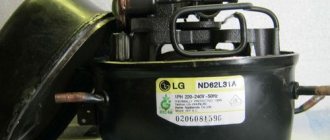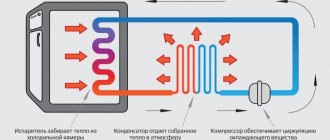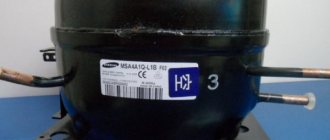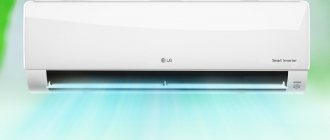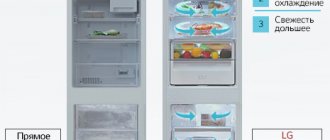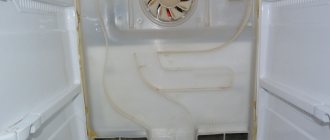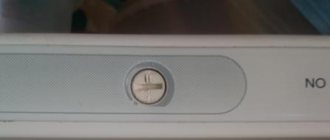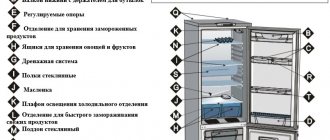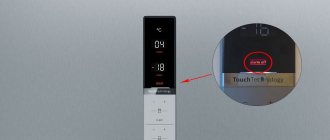Such a necessary household appliance as a refrigerator must be both economical and durable. An inverter compressor in a refrigerator is a very important component; let’s look at its pros and cons.
Household assistants can be one- or two-compressor; it is important to distinguish between them for further use of the unit. We're all interested in innovation these days, so before choosing a new refrigerator, you need to know about the best new products on the market.
The inverter compressor was recently developed, let’s look at its features, operating principle, advantages and disadvantages. According to experts, such engines undoubtedly have a great future.
Inverter compressor type
An inverter compressor, unlike a linear one, never turns off, but smoothly switches to another operating mode with a lower number of revolutions.
Technically, this can be explained as follows: there is a gradual conversion of alternating current into direct current, then the reverse process occurs, but a certain rotation speed is set.
A three-phase electric motor with a brushless system that rotates the compressor is used not only in modern household refrigerators, but also in the production of various mechanisms for the automotive industry, computer and medical equipment.
How to check an inverter compressor
To do this, you need to start the compressor without an inverter. Light bulbs are connected to it. When you turn on the generator, they should all light up. Otherwise there is a breakdown.
Checking the inverter compressor.
See alsoHeight of the kitchen countertop: standard height, dependence of height on height: how to calculate the parameters?
The principle of operation of the refrigerator
The compressor acts as the heart of the refrigerator. It pumps refrigerant (freon gas) through the condenser tubes, which can have two physical states: gaseous and liquid. The circulation of the refrigerant removes heat from the refrigerator chambers, reducing the temperature inside.
Previously, instead of inverter compressors, linear ones were installed in refrigerators. The principle of their work was cyclical. When the compressor turned on at full speed, it circulated the refrigerant through the system until the set temperature was reached. When the desired value was reached, the compressor was completely turned off.
When the temperature sensor in the refrigerator detects an increase in temperature, the compressor repeats the cycle. The cyclic operation is regulated by a special relay. Its operation is “informed” by a characteristic click that is heard before starting and stopping the compressor.
Operating in this mode leads to overheating of the linear compressor, which can lead to its failure. When such a compressor turns on, it puts a significant load on the electrical network, which is also a disadvantage.
- The disadvantages of such a system also include:
- significant energy consumption due to the compressor operating at full power;
- sufficient noise level;
- wide range of temperature fluctuations inside the refrigerator chambers.
The wide temperature range is due to the fact that the temperature sensor responds only to a certain value. In fact, it turns out that the temperature inside the refrigerator is already higher than the set value, and the compressor does not turn on, since the sensor does not register deviations by every degree.
Operating principle of an inverter compressor
When the linear compressor is operating, the device is started to its maximum. When the set cooling temperature is reached, automatic shutdown is triggered.
The relay controls the process of turning off and resuming operation of the refrigerator. At the moment of switching on and off, a click is triggered. A characteristic hum indicates that the engine is running.
When the refrigerator is constantly running at full power and frequently switched off, the device becomes very hot and after a certain time fails, after which the cooling device must be replaced. Another disadvantage: high electricity consumption due to increased electrical load.
In general, the device works on the same principle, with the exception of a few differences. When the inverter refrigerator cools to the required temperature, the operation does not stop, but there is a gradual decrease in speed and a decrease in the speed of the refrigerant. Thus, a certain temperature level is maintained.
When the refrigerator door is opened, the number of shaft revolutions increases based on a sensor signal indicating an increase in temperature and discrepancy with the required one. Unlike a linear generator, the new generator operates more smoothly, using minimal power.
If we explain inverter operation from a technical point of view, alternating current is converted into direct current, followed by the reverse process, but at the same time the required frequency is set.
Three-phase compressor motor with brushless system used in refrigerators is used in the production of automobile mechanisms, computers, medical equipment, etc.
The term inverter is found in other household appliances. In addition to refrigerators, the technology can be found in many types of home air conditioners.
The inverter system implies smooth power control when changing operating modes of the device. This does not change the general operating principle of the refrigerator. When the temperature increases, the sensor sends a signal to the compressor to switch to active operation mode.
When the set temperature value is reached, the temperature sensor reports this, and the inverter compressor reduces the speed without turning off. The speed of movement of the refrigerant is reduced to the level of maintaining the required temperature values.
A significant change in temperature inside the refrigerator compartment occurs when the door is opened. Having detected the changes, the sensor again signals this to the compressor, and it, gradually increasing power, returns the temperature to normal.
In this case, the entire system does not need to be fully turned on and, accordingly, the load on the electrical network does not increase, which is a plus.
Pros and cons of an inverter refrigeration system
The main advantage of this type of compressor is its low power consumption and long-term operation. Smooth, quick temperature control and silent operation are the advantages of household appliances with this type of engine.
When purchasing a refrigerator with an inverter motor, the warranty is issued for a period of about 10 years. This confirms the reliability of the device and the confidence of the manufacturer in the quality of its product.
However, a refrigerator with a linear compressor costs less than one with an inverter cooling system, so it continues to be in demand. Along with the high price, the inverter device has another disadvantage.
Changes in network voltage can lead to malfunction of the refrigerator, since this type of compressor is more complex than a conventional engine. The wiring in the room must be reliable. Otherwise, installation of stabilization devices is required.
Regardless of the presence of shortcomings, such a device is gaining popularity among buyers. Gradually, the market is filled with new, more improved models.
Modern production is not limited to refrigerators - the inverter compressor is already an integral part of air conditioners, washing machines and other household appliances.
Advantages and disadvantages
The inverter type of compressor has its strengths and weaknesses. Benefits include:
- Less power consumption compared to linear type.
Such refrigerators consume 10-20% less electricity, since they operate at full capacity only when they are turned on for the first time. After which the engine reduces speed and enters the mode of maintaining the set temperature. Refrigeration equipment with this type of compressor belongs to A+, A++, A+++ energy consumption classes.
- Longer service life.
Since there are no serious overloads in the operation of the engine, the wear of various parts of the mechanism is significantly reduced. This allows the equipment to work much longer.
For example, the manufacturer Samsung gives a ten-year warranty on its products, which indicates the reliability and high quality of household appliances with this type of engine.
- Low noise level.
Everyone knows that refrigerators are not the quietest appliance in the house. Often the monotonous sounds emanating from them can bring a lot of discomfort. The same cannot be said about inverter models.
This type is capable of operating almost silently, and the sound can only be heard when the device is turned on for the first time, when it is necessary to cool the chamber to the required temperature.
- Maintaining the temperature at the same level.
Unlike conventional refrigerators, where the temperature range is quite wide, inverter refrigerators allow you to maintain it at the same level, without sudden changes. Thanks to this, products are stored in more comfortable conditions.
- But this type of engine also has disadvantages:
- High price. Compared to refrigerators running on linear compressors, inverter ones are more expensive, and not everyone can afford to buy them. Over time, the equipment will certainly pay for itself through energy savings.
- Sensitivity to voltage surges. In some homes, this problem occurs quite often and equipment can be seriously damaged. Therefore, in order to protect the device, it is necessary to additionally purchase protective equipment.
- Manufacturers also offer models with a Volt Control system (for example, Samsung), which will protect the refrigerator from sudden voltage changes. If there is a power surge, the device will go into standby mode and then return to work on its own.
How is it different from normal
The linear type is a common compressor option that has been used for many years. We have already considered the differences in the principle of operation, so we are skipping them, but let us remind you that the inverter type operates constantly at low speeds, while the linear one turns on and off periodically, which is considered its main disadvantage.
Due to such inclusions, voltage surges occur in the home network and increased load; energy consumption is also quite high. New compressors have minimal electricity consumption due to their operation at low speeds and, accordingly, low power.
In addition, the inverter-type compressor works constantly, but is inaudible for the user; there is no usual rumbling and vibration of the case; it is more like the purring of a cat rather than the operation of the compressor.
Refrigerators with new compressors are quite confidently making their way to our apartments, but not all users can afford the cost of purchasing such equipment with the same quality of food preservation.
Older products have been working for some consumers for 30 years or more - judging by the reviews, they are not yet ready to retire.
Advantages and disadvantages of an inverter compressor
The main advantages of the equipment:
- economical energy consumption;
- low noise level;
- maintaining a stable temperature;
- safety even during power surges;
- long service life.
Minuses:
- sensitivity to electrical wiring;
- expensive equipment.
Before installing inverter refrigerators, you need to check the sockets and electrical wiring.
See also: Kitchen interior in Provence style - main aspects of design and decoration
Types of compressors for refrigerators
| Ordinary | Inverter | Inverter Linear | |
| Mechanism | Crank (rotary piston) | Crank with inverter control (rotary piston) | Linear mechanism without rotational movements |
| Principle of operation: | On off. (cannot change work intensity) | Constant work with varying intensity | Constant work with varying intensity |
| Friction points: | 3 or more | 3 or more | 1 |
| Wear: | High | Average | Low |
| Electricity consumption: | Relatively high (class A below) | Relatively low (usually class A+) | Low (usually class A++) |
There are four types of compressors - conventional, piston, linear, inverter and linear-inverter.
- Ordinary
A conventional compressor is an electric motor that rotates a conventional piston pump, which in turn pumps the refrigerant into the refrigerator. These are found in the most ancient refrigerators and are turned on either at 100% power or at 0%. This leads to temperature changes inside the refrigerator chambers.
- Piston.
Quite a popular type, often found in refrigeration units. It consists of one or more cylinders, which are located in a horizontal or vertical position. The working process is carried out during the reciprocating movement of the pistons, which is controlled by the connecting rod and crank mechanism.
Screw or rotary. Known since the end of the 19th century, the pressure difference arises due to the rotation of the rotor and the movable plate - in other words, these are two spirals threaded into each other.
During rotation, the refrigerant is quite strongly compressed and squeezed into the pipeline. These types of compressors are installed in some Indesit models.
- Linear.
A linear compressor differs from a conventional compressor in that it does not have an electric motor. Instead, there is an electromagnetic coil, in the core of which a pump piston is installed.
Such a compressor has no rotating parts, as a result of which it consumes less electricity, makes less noise (at the level of an inverter) and costs less. In the picture at the beginning of this article, this is exactly the compressor depicted. It also works either at 100% power or turns off completely.
This type of compressor is the most common. You can tell when the engine starts by clicking. But there are significant drawbacks here. Firstly, constantly running at full power can cause serious damage to the compressor.
Secondly, when the engine starts, the load on the network increases significantly, which entails high energy costs. These and many other shortcomings served as the reason for the introduction of inverter compressors into production.
- Inverter.
An inverter compressor is also an electric motor with a pump, but only with an adjustable shaft speed. The adjustment allows you to smoothly regulate the engine speed and thus maintain a constant temperature in the refrigerator chambers, as well as reduce its noise and energy consumption.
The engine speed control board is quite expensive, this is of course a minus.
The operation of the inverter compressor occurs smoothly, without sudden switching on and off. First, it starts up and cools the chamber inside the refrigerator to the desired (set) temperature, which it maintains constantly.
This type of engine does not turn off completely, but only reduces the speed to a minimum. As a result, the temperature in the chamber remains unchanged, which is a definite plus.
- Linear inverter.
It does not have an electric motor and can change the speed of the pump piston. This type of compressor is the quietest and most economical to date.
- There are two more types of compressors, but modern household refrigerators are very rarely equipped with them:
- oil-free - as a rule, they are equipped with large-volume industrial installations;
- electrogasdynamic products, where the required pressure is obtained due to the formation of space charges of particles in the electric field.
All types of compressors have a designated resource, as well as a maximum service life and require periodic maintenance.
If the compressor malfunctions in a household refrigerator, then the home technician should not try to fix anything - there are specialists from the service center for this.
Sectional view of a refrigeration compressor
Those who know the working principle of an internal combustion engine can easily guess what happens inside the compressor. Let's look at the compressor in cross-section:
We see there an electric motor, a piston and a valve system. The evaporated freon passes through and is immediately heated by compression, then exits under pressure towards the condenser. After this, it is easily converted into a liquid state, releasing energy, so that it can then be cycled again through a capillary expander.
Which type of refrigerator compressor is better?
Which type of refrigerator compressor is better: inverter or linear?
Rather than talk for a long time about the superiority of one species over another, let’s take a look at the table where we have summarized the main parameters and differences of each species:
| Characteristic | Differences: linear/inverter |
| Resource | Service life is limited/guaranteed for 10 years |
| Power-on current | Maximum at every power on / only at startup |
| Network load | Frequent power surges / no problem |
| Noise level | Relay clicks, compressor operation / almost silent |
| Adjustment | Identical in temperature inside |
| Wear of parts | Large/small |
To understand exactly which compressor works, you can compare them with the movement of a car: in the first case there are bumps and alternating ups and downs, and the second is a highway with a perfectly smooth surface and slight curvature in turns.
What is the difference between a two-compressor
Double compressor refrigerator. There are refrigerator models on the household appliances market that have two compressors installed. Such samples have several pumps, each of which is responsible for maintaining the required temperature in a specific chamber.
The freezer operates separately, the refrigerator operates separately. This system allows you to cool products faster, and is also convenient because you can turn off one of the compressors if there is no need to use it, for example, when the family goes on vacation.
Why one compressor is better than two
Many buyers believe that one compressor in a refrigerator has advantages over similar models with two pumps, in that the former are more economical than the latter.
This is also supported by people’s conviction that there is less noise emitted by a refrigerator with one compressor.
One compressor, cooling both chambers, does not choose which of them needs to pump more cold, which means it always simply works at maximum.
Perhaps the freezer does not currently require freezing, and warm foods were placed in the refrigerator, but the compressor will still turn on at the order of the thermometer and begin to cool both chambers. In addition, during the long absence of the owners in the house, when the freezer is turned on, the refrigerator compartment will also be cooled.
Modern linear inverter compressors are practically silent and operate without sudden starts, rattling or vibrations, so the number of installed compressors will not greatly affect the noise level.
An important parameter when choosing is cost. Now you can find inexpensive models of both types on the market, but devices with two pumps will still be more expensive than models with one pump.
Here, only knowledge of the expectations from the operation of the refrigerator will help you choose. It is impossible to say for sure which one is better. You must first decide on the tasks that the refrigerator should solve and only then choose a model.
What parameters influence when purchasing
- To choose the right refrigerator model, you need to determine the necessary parameters:
- The volume of the chambers, the number of stored products - a large family requires a large amount of food that needs to be stored in the refrigerator, which means it must cope with the rapid cooling of a large load of food. The downside is that if a person lives alone, he does not need a large volume at all.
- Frequency of long absences from home - if the owner is away on business trips for a long time, but wants frozen food waiting for him upon arrival, it makes sense to consider a two-compressor refrigerator, which can provide cooling only for the freezer compartment.
- Load on the electrical network - if small power sources are approaching the house, but the load on them is high, then it is better to take a closer look at the inverter type of compressor. They are sensitive to voltage changes, but they create less stress on the wiring.
If there are power outages
Like any electrical appliance, energy fluctuations are harmful to refrigerators. Severe voltage surges can damage the compressor. Replacing it is expensive. Therefore, it is better to secure its operation using the methods described in the previous paragraph.
If there is poor wiring in the room where the freezer will be installed, it is better to replace it with a new one.
This will cost less than possibly replacing the pump. It is also always important to remember about the need for grounding - the body of the refrigerator is often made of metal and can easily give an electric shock if accidentally touched in the event of a malfunction.
An interesting argument in favor of a two-compressor device is the following argument: if one of the pumps malfunctions, the second one will still continue to work, so the refrigerator can still be partially used.
Number of stored products
If there is a need to constantly store a large number of products, then it is better to purchase a device with two compressors. They will allow you to cool food more efficiently, thereby extending its shelf life. This is the primary task of the refrigerator, which means it is important that it copes with it.
If the unit is not loaded to capacity, but is used by a small family, then a single-compressor model is quite suitable.
The main thing to remember is that the more products are loaded into it, the higher the temperature becomes and the harder the pump will have to work to cool the chambers. Therefore, proper loading of the compartments will allow you to effectively use models with one pump.
If deep freezing is planned
When deep freezing of food is planned, maximum power is required from the compressor.
In order to effectively freeze a large amount of food, it is better to use a refrigerator with two compressors, because regardless of the temperature in the refrigerator compartment, the compressor responsible for it in the freezer will be focused on lowering the temperature in the minus compartment.
Inverter refrigerator disadvantages
The main disadvantages of refrigerators equipped with an inverter compressor include two things: high price and sensitivity to power surges. The cost of refrigerators with an inverter compressor is higher than with a conventional one, which is understandable - all new products are more expensive.
The technology has been present on the household appliances market for several years now, and a gradual reduction and stabilization of prices has already been observed. In any case, by overpaying now, you can save money when operating the refrigerator.
The disadvantage of poor tolerance to voltage changes can be easily solved. By connecting the refrigerator to the network through a voltage stabilizer, you will protect the device from surges.
If you decide to learn about the pros and cons of inverter compressors in a refrigerator because you are choosing a new device for storing food, then we recommend reading tips on choosing a refrigerator for your home.
Experts rightfully believe that this technology is the future. The number of refrigeration equipment produced with a conventional compressor is decreasing. The advantages of inverter compressors outweigh their disadvantages. These facts allow the technology to increasingly gain popularity and develop further.
Possible causes of failure of the inverter system
The equipment model under consideration has many advantages. It is characterized by a long service life, efficiency, and noiselessness. At the same time, equipment may fail sooner or later for various reasons.
Inverter processors are extremely sensitive to voltage fluctuations. Buyers often do not take this indicator into account when purchasing.
The high level of power in inverter refrigerators ensures minimal stress on the mechanical elements of the refrigerator.
You should check the wiring and outlets before purchasing. If there is a problem, appropriate action should be taken. This way you will prepare the ground for connecting new equipment and reduce the likelihood of a quick breakdown. Many refrigerators have a standard surge protection system installed to avoid this problem.
See alsoBeautiful and stylish dishes - features and tips for choosing
Refrigerators with inverter compressor reviews
- Samsung RB-30 J3200SS
Dimensions: 595x668x178 mm. Energy saving class: A+ (272 kWh/year). Total volume: 311 l. Freezer: 98 l. Refrigerator: 213 l. Climate class: N, SN, ST. Freezing capacity: 12 kg/day.
Autonomous cold preservation: 20 hours. Defrosting system: No Frost. Compressor type: inverter. Noise level: up to 39 dB. Weight: 66.5 kg.
Reviews
- Pros:
- stylish appearance;
- outdoor display;
- spacious;
- glass shelves;
- high quality build and all materials.
- Minuses:
- not identified
- Liebherr CN 4015
Dimensions: 600x625x201.1 mm. Energy saving class: A++ (229 kWh/year). Total volume: 356 l. Freezer: 87 l. Refrigerator: 269 l. Climate class: SN, T. Freezing power: 11 kg/day up to -24 degrees. Autonomous cold preservation: 18 hours. Defrosting system: Refrigerating chamber – drip. Freezer – No Frost. Sound pressure: 39 dB. Weight: 76.5 kg.
Reviews
- Pros:
- internal display;
- door closing indicator;
- shelf height adjustment;
- "vacation" mode;
- antibacterial protection;
- protection from children.
- Minuses:
- not identified
- LG GA-E429 SQRZ
Dimensions: 594x643x190.7 mm. Energy saving class: A++ (221 kWh/year). Total volume: 302 l. Freezer: 79 l. Refrigerator: 223 l. Climate class: N, SN, ST.
Compressor: linear inverter. Defrosting system: Total No Frost. Noise level: 39 dB. Weight: 70 kg.
Reviews
- Pros:
- super freezing;
- Wi-Fi, Smart Diagnostics;
- touchscreen;
- Bio Shield door seal;
- shelf for wine bottles.
- Minuses:
- Some users complain about noise from the compressor.
- LG GW-B499 SQGZ
Dimensions: 595x665x201 mm. Energy saving class: A++ (266 kWh/year). Total volume: 343 l. Freezer: 223 l. Refrigerator: 93 l. Zero chamber: 27 l. Climate class: N, SN, ST and T.
Freezing capacity: 9 kg/day. Autonomous cold preservation: 16 hours. Defrosting system: No Frost. Compressor type: inverter linear type. Sound pressure: 37 dB. Weight: 82 kg.
Reviews
- Pros:
- excellent ratio of shelves and drawers;
- separate NatureFRESH freshness zone;
- nice design;
- high quality materials.
- Minuses:
- not identified
- Samsung RB-30 J3200EF
Dimensions: 595x668x178 mm. Energy saving class: A+ (272 kWh/year). Total volume: 311 l. Freezer: 98 l. Refrigerator: 213 l. Climate class: SN, ST.
Freezing capacity: 12 kg/day. Autonomous cold preservation: 20 hours. Defrosting system: No Frost. Compressor type: inverter. Noise level: 39 dB. Weight: 66.7 kg.
Reviews
- Pros:
- ideal cost-quality ratio;
- strict, laconic appearance;
- quiet, high-quality work;
- abundance of containers for freezing;
- does not require defrosting;
- Easy to clean glass shelves.
- Minuses:
- not identified
Video: Repairing an inverter compressor
see also
Freshness zone in the refrigerator - what is it?
Landscape design options for a site on a slope, photo.
Curtains for the bedroom: in life as in the photo
Functional kitchen design with sofa
Small kitchen design – interesting design ideas
Design features of a narrow kitchen
TV in the kitchen: how to choose, placement options, tips.
Beautiful and stylish dishes - features and tips for choosing
Kitchen countertop height: standard height, height dependent on height: how to calculate the parameters?
Kitchen interior in Provence style - main aspects of design and decoration
Do-it-yourself restoration of the refrigerator door seal.
What types of hoods are there? Shapes of modern exhaust devices
